Name Columbia Sponsored by Miss J. A. Paschal Decommissioned 30 November 1946 Launched 17 December 1941 Beam 20 m | Laid down 18 August 1940 Commissioned 29 July 1942 Construction started 18 August 1940 Length 186 m | |
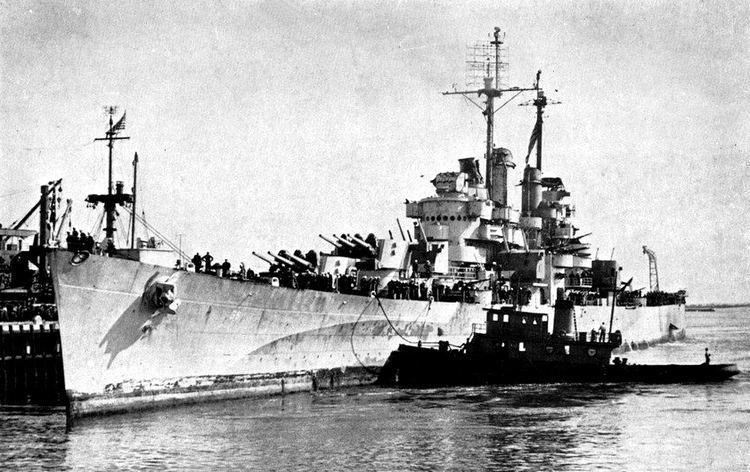 | ||
USS Columbia (CL-56) was one of 26 United States Navy Cleveland-class light cruisers completed during or shortly after World War II. The ship, the sixth US Navy ship to bear the name, was named for the city of Columbia, South Carolina. Columbia was commissioned in July 1942, and saw service in several campaigns in the Pacific. Like almost all her sister ships, she was decommissioned shortly after the end of the war, and never saw active service again. Columbia was scrapped in the early 1960s. A memorial to the ship and men who served on her exists in Columbia, SC.
Contents
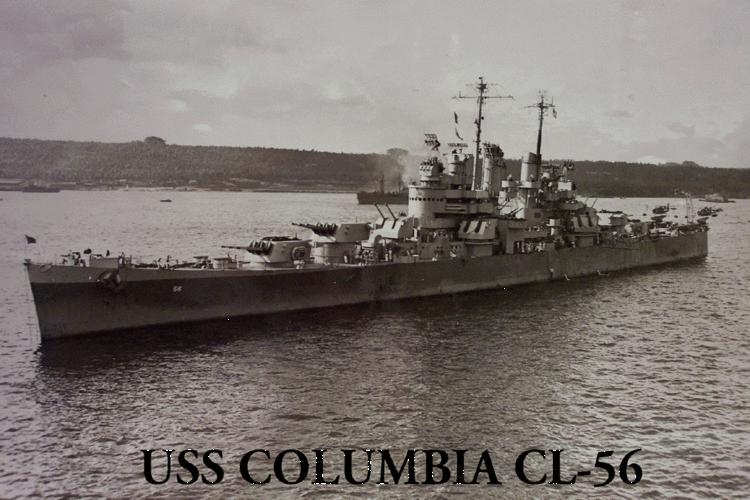
Construction and commissioning
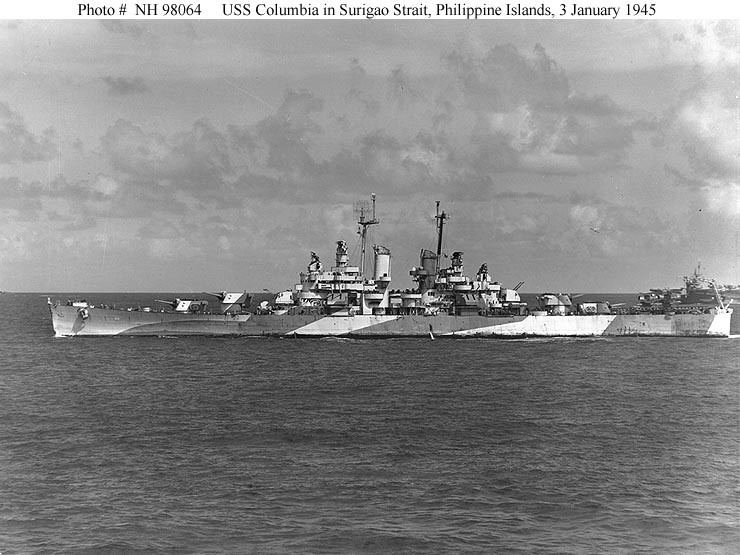
Columbia was laid down on 18 August 1940 by the New York Shipbuilding Corp., Camden, New Jersey; and launched on 17 December 1941 sponsored by Miss J. A. Paschal. She was commissioned on 29 July 1942, with Captain W. A. Heard in command.
1942-43
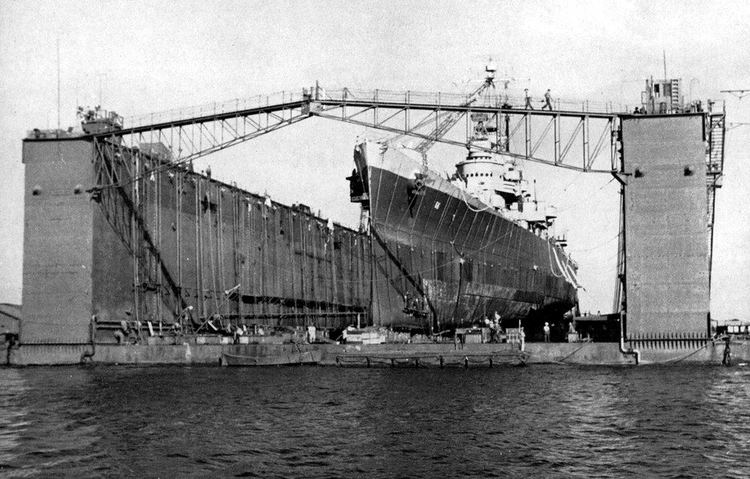
Sailing from Norfolk on 9 November 1942, Columbia arrived at Espiritu Santo, New Hebrides on 10 December, and joined in the patrols west of the New Hebrides in support of the continuing struggle for Guadalcanal. On 29 January 1943, while cruising off Rennell Island to cover the movement of transports to Guadalcanal, Columbia's group came under heavy air attack, and the battle of Rennell Island followed, with land and carrier-based aircraft joining in to protect the American ships. Columbia aided in shooting down three enemy planes in this battle. Based out of Efate from 1 February, Columbia continued her patrols in the Solomons, and in June carried out a bombardment and mining mission on 29–30 June, coordinated with the New Georgia landings. On 11–12 July, she bombarded Munda, and until 5 September, when she sailed for a brief overhaul at Sydney, patrolled southeast of the Solomons.

Columbia, rejoined her division on 24 September off Vella LaVella, as patrols to intercept Japanese shipping continued. As Marines stormed ashore on Bougainville on 1 November, Columbia's guns pounded targets on Buka and Bonis and in the Shortlands. On the night of 2 November, her force intercepted a Japanese group sailing to attack transports lying off Bougainville. In the furious fighting of the Battle of Empress Augusta Bay which resulted, Columbia joined in sinking the Japanese cruiser Sendai and destroyer Hatsukaze, and turning the attackers back from their goal. She continued to support the Bougainville landings and bombard targets in the Solomons through December.
1944

After training exercises in the New Hebrides in January 1944, Columbia helped spearhead the attack and occupation of Nissan, one of the Green Islands from 13 to 18 February. Early in March, her group swept along the line between Truk and Kavieng in search of enemy shipping, then covered the assault and occupation of Emirau Island from 17 to 23 March. On 4 April, Columbia sailed from Port Purvis for an overhaul at San Francisco, returning to the Solomons on 24 August.
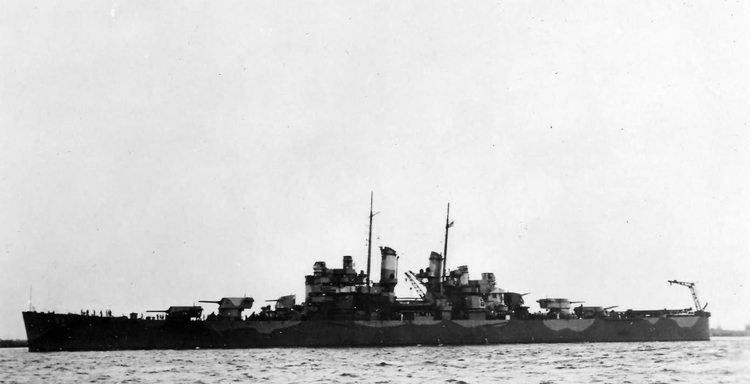
Columbia sortied from Port Purvis on 6 September with the covering force for the landings in the Palaus, and remained off Peleliu to provide gunfire support to forces ashore and protection to assault shipping until her return to Manus on 28 September. She sailed on 6 October, guarding the force which was to seize Dinagat and other islands at the entrance of Leyte Gulf which must be neutralized before the vast Leyte invasion fleet could enter the Gulf. These islands were taken on 17 October, and Columbia sailed on to give gunfire cover to the main landings three days later. But as the landings proceeded, the Japanese fleet sailed south to give battle, and on the night of 24 October, its southern force entered Leyte Gulf through Surigao Strait. Attacks by motor torpedo boats and destroyers on the Japanese force opened this phase of the decisive battle for Leyte Gulf. Columbia with other cruisers had joined the old battleships and lay in wait. In a classical maneuver, the American ships "crossed the T" of the Japanese column, and opened heavy gunfire which sank the battleship Yamashiro, and forced the heavily damaged cruiser Mogami and other units to retire. Toward dawn, Columbia sped to deliver the final blows which sank destroyer Asagumo, crippled in earlier attacks.
After replenishing at Manus early in November, Columbia returned to Leyte Gulf to protect reinforcement convoys from air attack. In December, operating from Kossol Roads in the Palaus, she covered Army landings on Mindoro, and on 14 December, lost four of her men when a 5-inch (127 mm) gun misfired during an air attack. These were Columbia's first casualties of the war.
1945
On 1 January 1945, Columbia sailed for the landings in Lingayen Gulf and on 6 January, as pre-invasion bombardments were getting underway, Japanese kamikaze attacks began. Columbia suffered a near miss by a kamikaze and then another of the kamikaze planes struck on her port quarter by a second. The plane and its bomb penetrated two decks before exploding, killing 13 and wounding 44 of the crew, putting her aft turrets out of action, and setting the ship afire. Prompt flooding of two magazines prevented further explosions, and impressive damage control measures enabled Columbia to complete her bombardment with her two operative forward turrets, and remain in action to give close support to underwater demolition teams. Ammunition was removed from the after magazines to refill the forward magazines; much of this was done by hand. On the morning of the landings, 9 January, as Columbia lay close inshore and so surrounded by landing craft that she was handicapped in maneuver, she was again struck by a kamikaze, knocking out six gun directors and a gun mount. 24 men were killed and 97 wounded, but short-handed as she was, Columbia again put out fires, repaired damage, and continued her bombardment and fire support. Columbia sailed that night, guarding a group of unloaded transports. Her crew's accomplishments in saving their ship and carrying out their mission without interruption were recognized with the Navy Unit Commendation for this operation.
Columbia received emergency repairs at San Pedro Bay, Leyte, and sailed on to an overhaul on the west coast, returning to Leyte on 16 June. Three days later, she sailed for Balikpapan, Borneo, off which she lay from 28 June, guarding minesweeping which preceded the invasion of the island on 1 July. She covered the landing of Australian troops, and gave them gunfire support through the next day, sailing then to join Task Force 95 (TF 95) in its repeated sweeps against Japanese shipping in the East China Sea. At the close of the war, she carried inspection parties to Truk, the important Japanese base bypassed during the war, and carried Army passengers between Guam, Saipan, and Iwo Jima until sailing for home on 31 October.
After calling on the west coast, Columbia arrived at Philadelphia on 5 December for overhaul and service training Naval Reserve men until 1 July 1946. She was decommissioned and placed in reserve at Philadelphia on 30 November 1946, and sold for scrapping on 18 February 1959. In an odd coincidence, the tug that towed Columbia to the breakers, the Triton, owned by Curtis Bay Towing, was also one of the tugs present at her launching, 18 years earlier.
Awards
In addition to the Navy Unit Commendation, Columbia received 10 battle stars for World War II service.
Columbia flew a Confederate Navy Ensign as a battle flag throughout combat in the South Pacific in World War II. This was done in honor of the ship's namesake, the capital city of South Carolina, the first state to secede from the Union.
